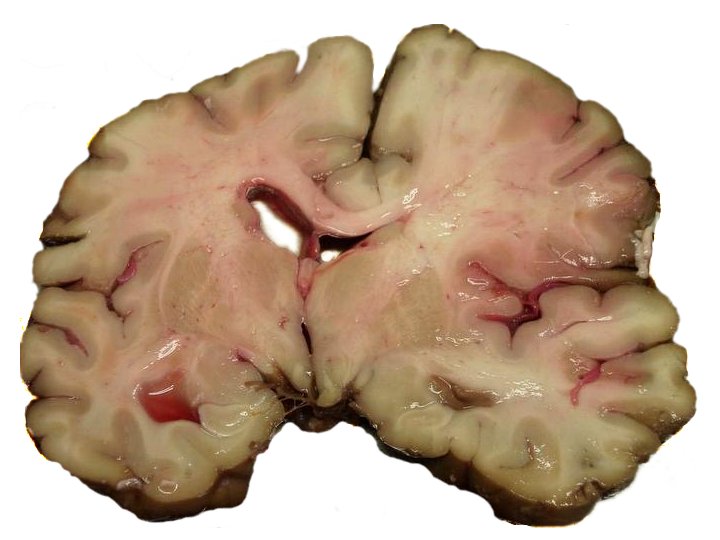Ischemic stroke
For patient information click here
| Stroke | |
 | |
|---|---|
| A slice of brain from the autopsy of a person who suffered an acute MCA stroke | |
| ICD-10 | I61-I64 |
| ICD-9 | 434 |
| OMIM | 601367 |
| DiseasesDB | 2247 |
| MedlinePlus | 000726 |
| MeSH | D020521 |
|
Stroke Main page | |
|
Diagnosis | |
|---|---|
|
Treatment | |
|
Case Studies | |
|
Ischemic stroke On the Web | |
|
American Roentgen Ray Society Images of Ischemic stroke | |
Editor-In-Chief: C. Michael Gibson, M.S., M.D. [1]
Overview
Definition
Historical Perspective
Epidemiology & Demographics
Risk Factors
Prognosis
Classification
Pathophysiology
Diagnosis
History & Symptoms | Physical Examination
Imaging
For diagnosing ischemic stroke in the emergency setting:[1]
- CT scans (without contrast enhancements)
- sensitivity= 16%
- specificity= 96%
- sensitivity= 83%
- specificity= 98%
For diagnosing hemorrhagic stroke in the emergency setting:
- CT scans (without contrast enhancements)
- sensitivity= 89%
- specificity= 100%
- MRI scan
- sensitivity= 81%
- specificity= 100%
For detecting chronic hemorrhages, MRI scan is more sensitive.[2]
For the assessment of stable stroke, nuclear medicine scans SPECT and PET/CT may be helpful. SPECT documents cerebral blood flow and PET with FDG isotope the metabolic activity of the neurons.
Underlying etiology
When a stroke has been diagnosed, various other studies may be performed to determine the underlying etiology. With the current treatment and diagnosis options available, it is of particular importance to determine whether there is a peripheral source of emboli. Test selection may vary, since the cause of stroke varies with age, comorbidity and the clinical presentation. Commonly used techniques include:
- an ultrasound/doppler study of the carotid arteries (to detect carotid stenosis) or dissection of the precerebral artieries
- an electrocardiogram (ECG) and echocardiogram (to identify arrhythmias and resultant clots in the heart which may spread to the brain vessels through the bloodstream)
- a Holter monitor study to identify intermittent arrhythmias
- an angiogram of the cerebral vasculature (if a bleed is thought to have originated from an aneurysm or arteriovenous malformation)
- blood tests to determine hypercholesterolemia, bleeding diathesis and some rarer causes such as homocysteinuria
Treatment
Early assessment | Ischemic Stroke | Hemorrhagic stroke
Care and rehabilitation
Prevention
ACC/AHA Guidelines
Sources
- The 2004 ACC/AHA Guidelines for the Management of Patients With ST-Elevation Myocardial Infarction [3]
- The 2007 Focused Update of the ACC/AHA 2004 Guidelines for the Management of Patients with ST-Elevation Myocardial Infarction [4]
References
- ↑ Chalela, J (2007). "Magnetic resonance imaging and computed tomography in emergency assessment of patients with suspected acute stroke: a prospective comparison". Lancet. 369 (9558): 293–8. PMID 17258669. Retrieved 2008-01-22. Unknown parameter
|coauthors=ignored (help) - ↑ Kidwell, C (2004). "Comparison of MRI and CT for detection of acute intracerebral hemorrhage". JAMA. 292 (15): 1823–30. PMID 15494579. Retrieved 2008-01-22. Unknown parameter
|coauthors=ignored (help) - ↑ Antman EM, Anbe DT, Armstrong PW, Bates ER, Green LA, Hand M, Hochman JS, Krumholz HM, Kushner FG, Lamas GA, Mullany CJ, Ornato JP, Pearle DL, Sloan MA, Smith SC, Alpert JS, Anderson JL, Faxon DP, Fuster V, Gibbons RJ, Gregoratos G, Halperin JL, Hiratzka LF, Hunt SA, Jacobs AK (2004). "ACC/AHA guidelines for the management of patients with ST-elevation myocardial infarction: a report of the American College of Cardiology/American Heart Association Task Force on Practice Guidelines (Committee to Revise the 1999 Guidelines for the Management of Patients with Acute Myocardial Infarction)". Circulation. 110 (9): e82–292. PMID 15339869. Unknown parameter
|month=ignored (help) - ↑ Antman EM, Hand M, Armstrong PW; et al. (2008). "2007 Focused Update of the ACC/AHA 2004 Guidelines for the Management of Patients With ST-Elevation Myocardial Infarction: a report of the American College of Cardiology/American Heart Association Task Force on Practice Guidelines: developed in collaboration With the Canadian Cardiovascular Society endorsed by the American Academy of Family Physicians: 2007 Writing Group to Review New Evidence and Update the ACC/AHA 2004 Guidelines for the Management of Patients With ST-Elevation Myocardial Infarction, Writing on Behalf of the 2004 Writing Committee". Circulation. 117 (2): 296–329. doi:10.1161/CIRCULATIONAHA.107.188209. PMID 18071078. Unknown parameter
|month=ignored (help)
ar:سكتة zh-min-nan:Tiòng-hong ca:Accident vascular cerebral de:Schlaganfall da:Apopleksi el:Εγκεφαλικό επεισόδιο eo:Apopleksio ko:뇌경색 hr:Moždani udar io:Vaskulala cerebrala stroko id:Stroke is:Heilablóðfall it:Ictus he:שבץ מוחי la:Ictus (morbus) hu:Agyvérzés mk:Мозочен удар ms:Angin ahmar nl:Beroerte no:Hjerneslag sl:Možganska kap fi:Aivoverenkiertohäiriö sv:Slaganfall
- Pages with citations using unsupported parameters
- CS1 maint: Multiple names: authors list
- CS1 maint: Explicit use of et al.
- Aging-associated diseases
- Cardiovascular diseases
- Causes of death
- Medical emergencies
- Neurology
- Neurological disorders
- Emergency medicine
- Cardiology
- Neurosurgery
- Mature chapter
- Disease state